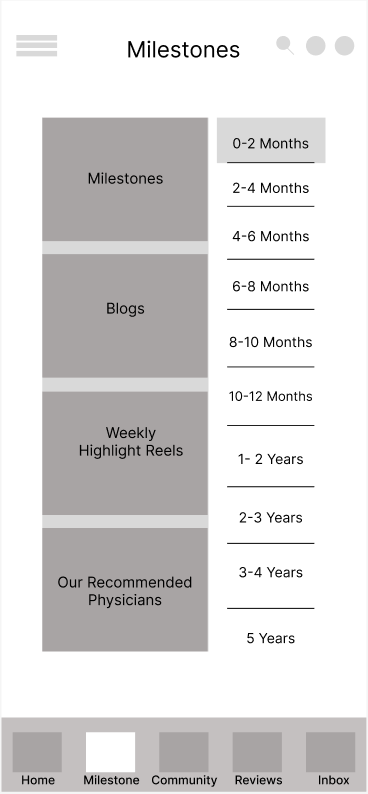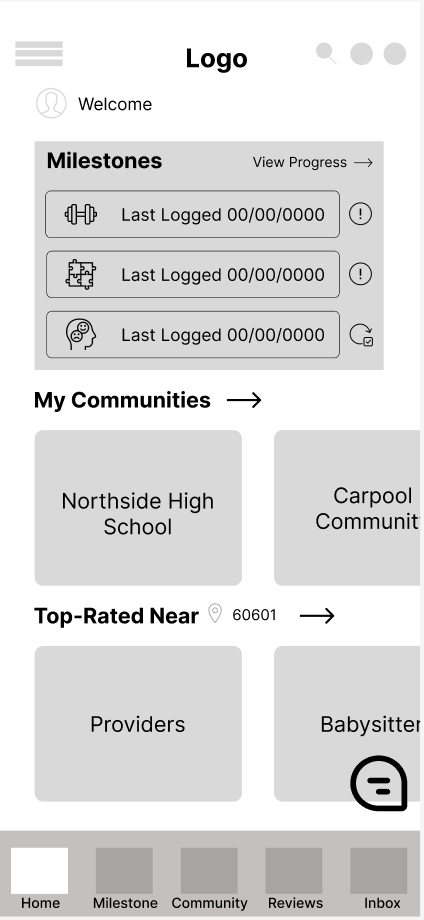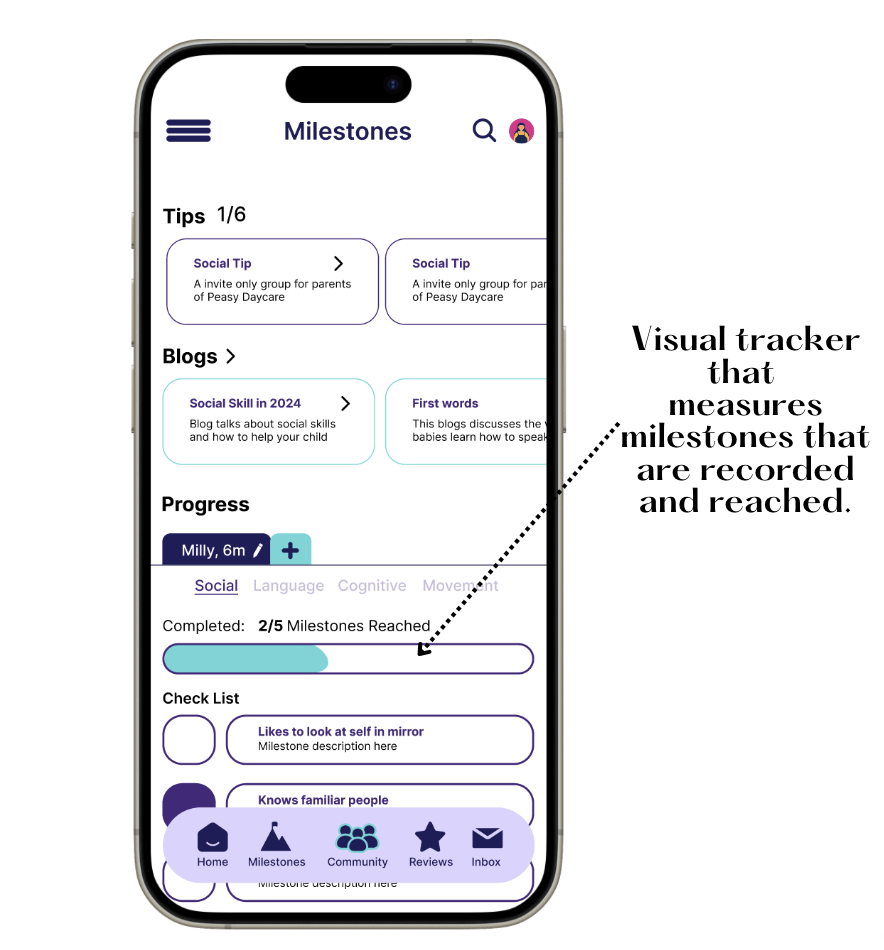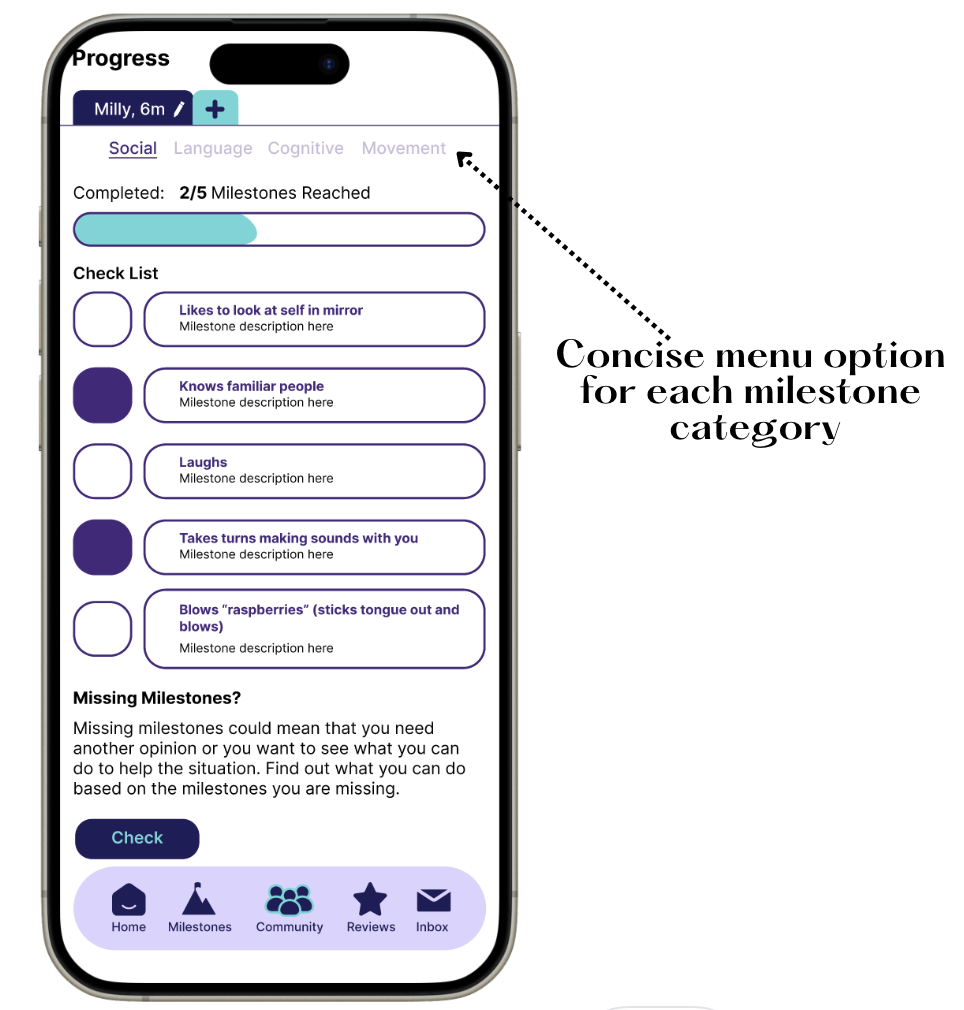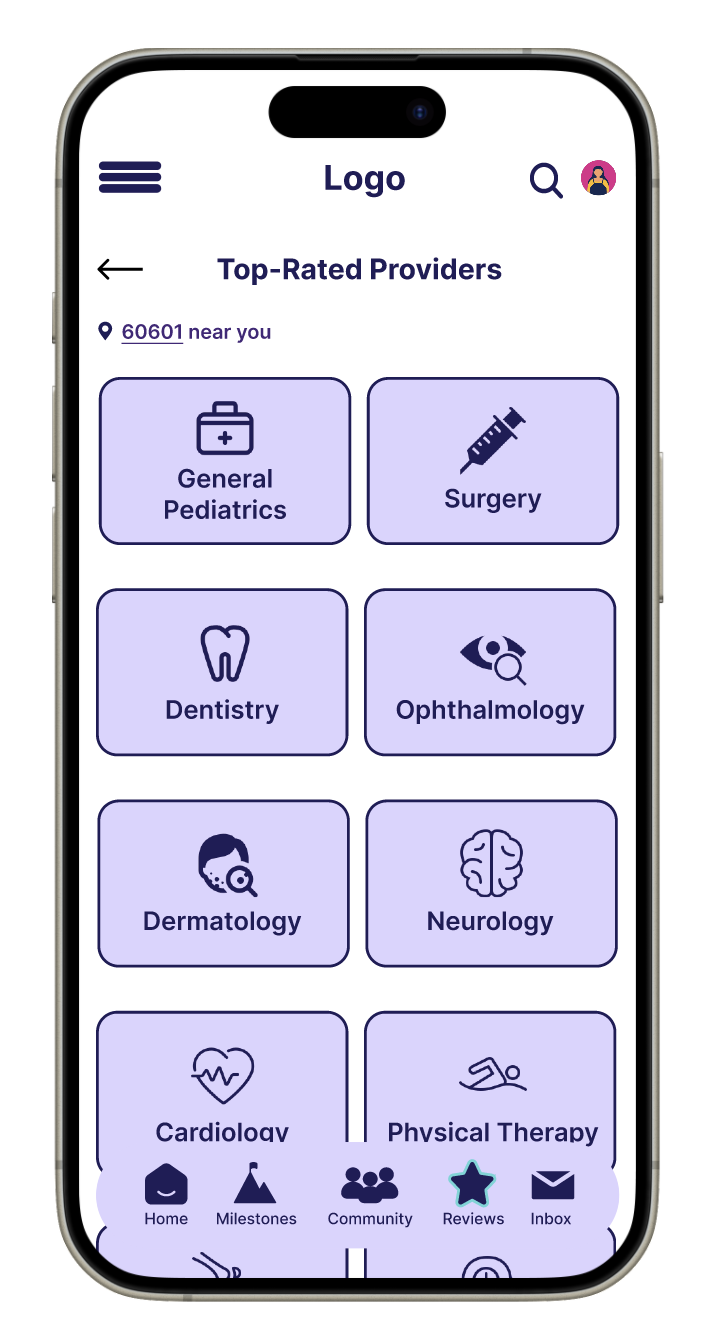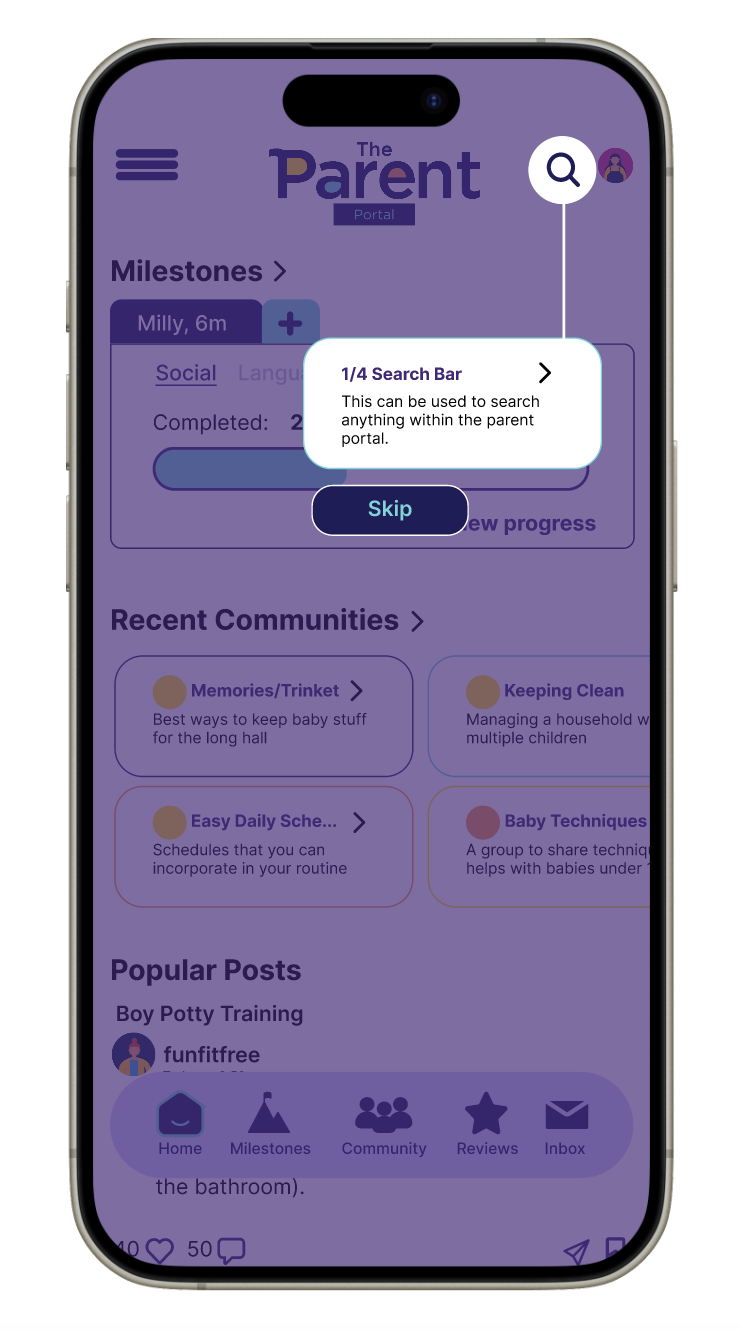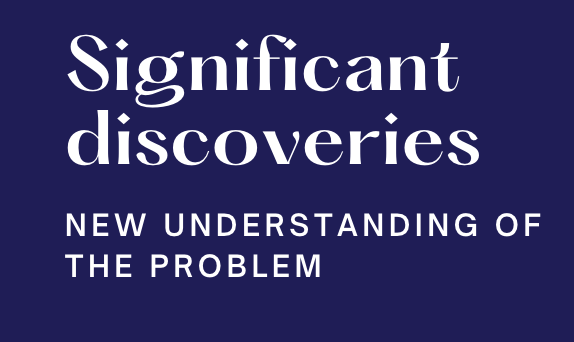An Interactive Parenting Platform that equips parents with tools and resources.
Tool: Figma
Role: UX Designer and Researcher
Background
I wanted to explore the facets of parenthood as it pertains to childhood development and child rearing. I was curious to learn from parents about their tactics, pain points, and processes they experienced and if there were any improvements that could be implemented. I took into consideration that there would be several supporting documents surrounding child development and decided to move forward with this topic.
Project Goals and Motivations
The project is driven by the challenges of modern parenting, amplified by the abundance of conflicting advice online. To address this, I’m developing an interactive app to support parents in navigating child rearing and development.
By providing reliable information and building a supportive community, I aim to empower parents, improve their quality of life, and offer a platform where they can seek advice, find local support, and track their child's milestones and teaching.
Competitive Analysis
Happy Child Parenting App
Comprehensive range of features
Includes milestone tracking, health tips, and a supportive community
Interface can be overwhelming, with some users reporting difficulty in navigation
ERA Parenting Relationships
Focuses on fostering communication between parents and children
Features behavior tracking and personalized advice
Lacks a strong community aspect, which may limit its appeal
Wonder Weeks
Focuses on child development stages
Provides insights into child's behavior and needs
Lacks practical features such as caregiver recommendations
Methods
I conducted a card sort based on interview insights to organize the app's content logically, and tested the prototype in two sprints with 4 participants each, refining it based on feedback to create a more user-friendly and effective design. A card sort was used to help concise categories, interviews brought awareness to parent’s pain points, and the design sprint allowed two opportunities to quickly test and reiterate design issues.
A card sort was conducted both in-class and offline to gather insights on how users would organize information for the application. These insights significantly informed the design of our application. A codebook was developed and used to mapped information out in FigJam.
A design sprint was utilized to prototype and conduct user testing early on. The prototype was then tested in two sprints with 4 participants per sprint. Feedback from the first sprint was used to refine and edit the prototype.
Interviews
Insights from these interviews guided the design process, ensuring that the app addressed the real needs and concerns of parents. The interview insights not only influenced the prototype but also informed the categories for the card sort.
Card Sorting
Design Sprints
User interviews were conducted remotely over Zoom to better understand target users’ motivations, goals, and pain points.
This exercise helped organize the app's content in a logical and intuitive manner, ensuring that parents could easily find and access the information they needed.
-
Establish proposed solution to determine the number of screens needed to complete each scenario-based task
-
Start Prototyping
-
Discussed prototype, testing, feedback, and evaluation during meetings to make last-minute fixes.
-
Conduct testing with participants
Pivot Left
Initially, I aimed to enhance interaction with parenting resources. However, after interviewing 8 parents, I found a strong reliance on community support. This led to pivoting towards creating an app that supports parents through online community chat boards, valuable resources, and a milestone tracker for their child's development.
Interview Results: Research Findings and Highlights
Local Community
Participants conveyed feelings and detailed personal experiences of the importance of joining in person and online communities.
Trust
Participants expressed various levels and approaches to gaining trust from online sources, health care professionals and interactions from other parents.
A Change of Direction based on on User Feedback
Implications for Design
Community-Locality
The community aspect was an important part of parenting. Having a community and getting advice is the best part of community to many participants.
Trust
The trust gauge from the participants varied but all used disconcertment, and “gut feelings” to distinguish good advice and bad advice or trustworthiness.
Healthcare Resources
Access to healthcare information and/or professionals at their convenience was a top priority for participants.
Provide Tools
Participants communicated a desire of possessing tools such as recommendations on various topics, books, best daycares, physicians, etc to support their parenting journey.
As a result of user interviews, I decided to pivot the focus from developing an application that provides parents with information on childrearing and development to creating an app that offers support by connecting parents through online community chat boards and providing resources like recommendations to local health care professionals.
Old Research Questions What we thought we should solve
From the literature review, I recognized a need to support parents in child-rearing. While researching, I identified critical questions to explore.
How do we equip parents with resources and a community for healthy child-rearing and development?
How do parents integrate new child-rearing information into their parenting?
How do we encourage parents to adopt healthy child-rearing and development methods?
What are parents’ parameters when it comes to trusting in information on child-rearing?
Providing tools recommendations
Parent that used online communities praised the tools they were given to help raise their child and to hear from experienced individuals.
New Research Questions What users want us to solve
Through user interviews, I refined the research questions based on valuable feedback and insights into the desires and challenges expressed by participants.
What types of resources and recommendations do parents seek for healthcare and developmental milestones?
What factors influence parents' trust and engagement with online parenting communities?
What are the primary needs and challenges faced by parents in their daily lives?
How can online connections enhance the parenting experience?
Healthcare Professional resources
All participants valued healthcare professional resources and liked recommendations from other people on great people to go to.
User Sprint Results
Participants varied in their trust assessments but commonly relied on gut feelings to discern advice or trustworthiness. Community support emerged as crucial, with many valuing the advice and camaraderie found within. Participants highly valued healthcare professional recommendations, highlighting the importance of trusted referrals.
Milestones
First round of user tests revealed tons of confusion regarding the information architecture of this layout. Many were unsuccessful at completing this task.Chatbox
Most users did not utilize the chatbox as it was intended due to their discomfort and oversight, resulting in its removal.Creating Groups
Participants expressed feelings of overwhelm when navigating to create a group due to the amount of options.
Low Fidelity Wireframes Sprint #1
Community Screen
Community is used to connect parents locally and globally to other parents seeking advice.
“It's nice getting advice from people my age and going to the same thing with their kids. Sometimes with parenting you feel alone and you don't understand what's going on, so it's nice. Connect with somebody like minded and you just going through the same thing you are.”
-Participant 3
Milestones Screen
Milestone is a tool to easily track milestones your child should be hitting and then find help if they are missing them.
Something that will show you what they're supposed to be at developmentally, what they supposed to do at each age and which stage and how. Maybe how to encourage them to do those things instead of allowing them to get behind developmentally.
Different activities to help them make sure they meet their developments and milestones...“Up to date information regarding like. Kid stuff cause like. Stuff changes so much so.
-Participant 3
Chatbox Screen
Gives you the option to ask a question quickly about your child without having to search for it. it uses AI to answer your questions.
“It takes a village...to raise a child. And that's because, you know we don't know it all. So it's always good to seek counsel from those wiser than us.”
Participant 7
Implemented Changes Protoypes
The usability testing data yielded several key insights into the usability of the app's features and the preferences of its potential users. The results indicate both strengths and areas for improvement, particularly in navigation, labeling, and community engagement features.
Milestones Implemented Changes
Milestone is a tool to easily track milestones your child should be hitting and then find help if they are missing them.
Provider Reviews Implemented Changes
Review revisions on the look and feel of the reviews and what was included as well as the steps and flow to get to the reviews.
#2 User Sprint Results
The goal of this phase was to integrate all iterations based on feedback from both rounds of testing into a version that meets user needs and expectations.
Create/Add Button
Although users were able to successfully complete all 6 tasks, 3/4 users expressed concerns regarding this feature. It was not clear.Well Organized
4/4 users stated that labels were clearly presented and easily understood.Stronger Signifiers
Users were unaware that certain features enabled Interaction.
Sprint #2 Implemented Changes
Review revisions on the look and feel of the reviews and what was included as well as the steps and flow to get to the reviews.
Opportunities for Further Work
There are several opportunities for further development of Parent Portal. Based on the foundation of gathered research, and efforts, these offer potential to further improve the applications usability effectiveness and parenting experience. These include:
Conduct further research
Explore additional features
Evaluate the impact of the app
Address cultural diversity
Diversify participant pool - most participants were 30 years of age or older
Implement other forms of user research such as first click or tree jack testing to understand information architecture more
User interviews taught the importance of listening and advocating for the user. I made the decision to pivot the scope of the project as a result.
Interviews and user testing revealed that participants need clear pathways to retrieving information regarding their child’s health and dislike communicating through a chatbox.
Both rounds of user testing produced positive results that played a critical role in the design process. Users enjoyed this app and shared their hopes of using it in the future.










